Last updated on April 19th, 2024 at 08:36 am
In the world of indoor gardening, big-leaf houseplants stand out as majestic and impressive additions to any living space. Their lush foliage not only adds a touch of nature but also creates a statement of elegance and grandeur. In this article, we will explore the allure of big-leaf houseplants, their various types, and the essential care tips to ensure they thrive in your home.
Contents
Types of Big-Leaf Houseplants
1- Fiddle Leaf Fig
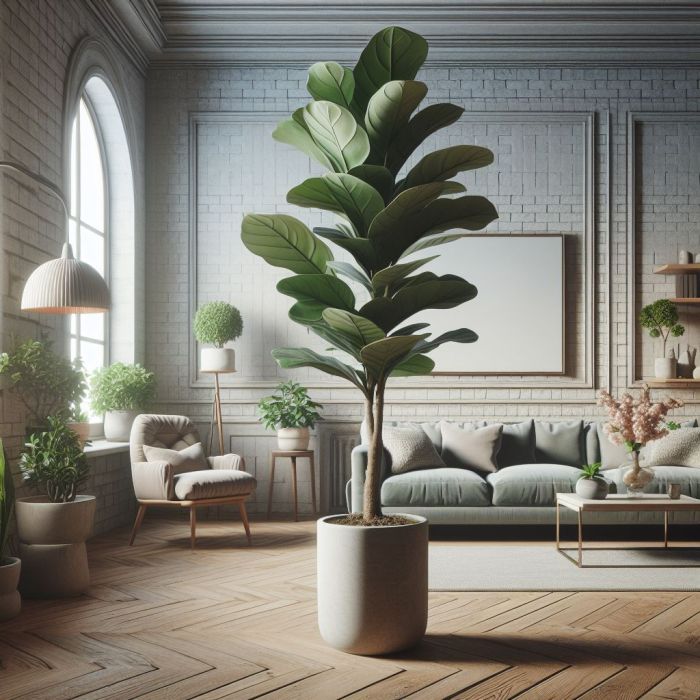
The Fiddle Leaf Fig, scientifically known as Ficus lyrata, stands out as a captivating big leaf houseplant with an eye-catching leaf structure. Its leaves are large, violin-shaped, and can grow up to 15 inches in length. The surface is glossy, creating a luxurious sheen that contributes to its overall appeal. The vibrant green color of its leaves adds a touch of nature’s brilliance to any indoor space.
Fiddle Leaf Figs can be shaped in various ways through pruning, allowing for a personalized touch to your indoor garden. For indoor cultivation, Fiddle Leaf Figs can be kept at a manageable size through regular pruning.
- Difficulty in Care
The Fiddle Leaf Fig is really pretty, but it can be a bit tricky to take care of. It likes bright, indirect light, but gets upset if you change its surroundings too much. Giving it too much water can make its roots rot, and it might attract bugs if you don’t look after it properly. But, if you pay attention to what it likes, it can be a great plant friend and make your place look awesome!
- Growth under the Right Conditions
Under optimal conditions, fiddle-leaf figs can produce even larger leaves. Adequate sunlight, proper watering, and well-draining soil contribute to robust growth. When planted outdoors, these majestic plants can grow into substantial green wonders, adding a statement piece to your outdoor landscape.
- Toxicity to Humans and Pets
It’s important to note that the leaves of the Fiddle Leaf Fig contain compounds that can be toxic if ingested by humans, cats, or dogs. Therefore, it’s advisable to keep the plant out of reach of curious pets and children.
2- Monstera Deliciosa
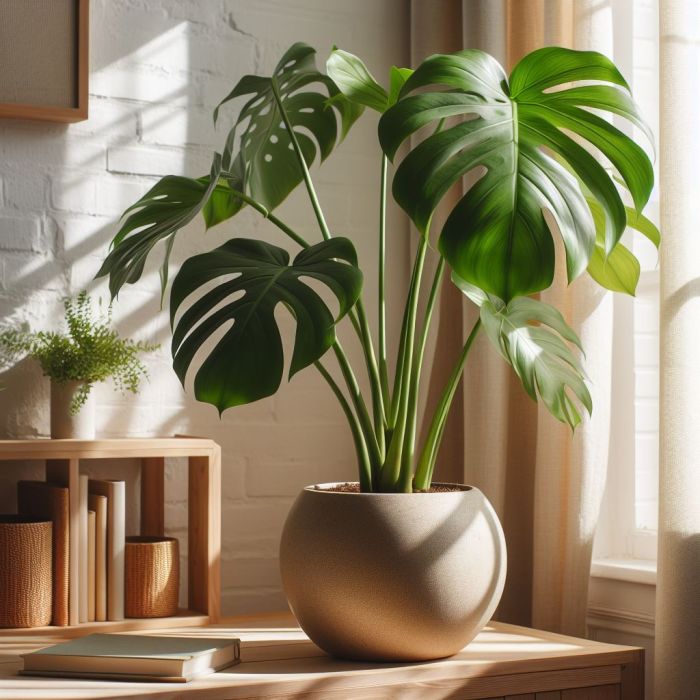
Monstera Deliciosa, or the Swiss Cheese Plant, is famous for its cool leaves that have lots of holes, like Swiss cheese. As these leaves grow up, they get more holes and splits, making a pretty pattern. This plant can get tall, up to 8 feet or even more, making it a big-leaf houseplant that stands out. It’s like having a green friend with a stylish leaf design in your home.
- Care
Monstera Deliciosa is celebrated for its relatively easy care requirements. It needs bright, indirect light, and can tolerate lower-lit conditions. Allow the top inch of soil to dry out before watering, and ensure well-draining soil to prevent waterlogged roots. Regular wiping of its broad leaves helps keep them dust-free and enhances the plant’s ability to absorb light.
- Toxicity
While Monstera Deliciosa is a captivating addition to indoor spaces, it’s important to note that the plant contains oxalates, which can be toxic if ingested. Extra care should be taken to keep it out of reach of children and pets.
3- Bird of Paradise
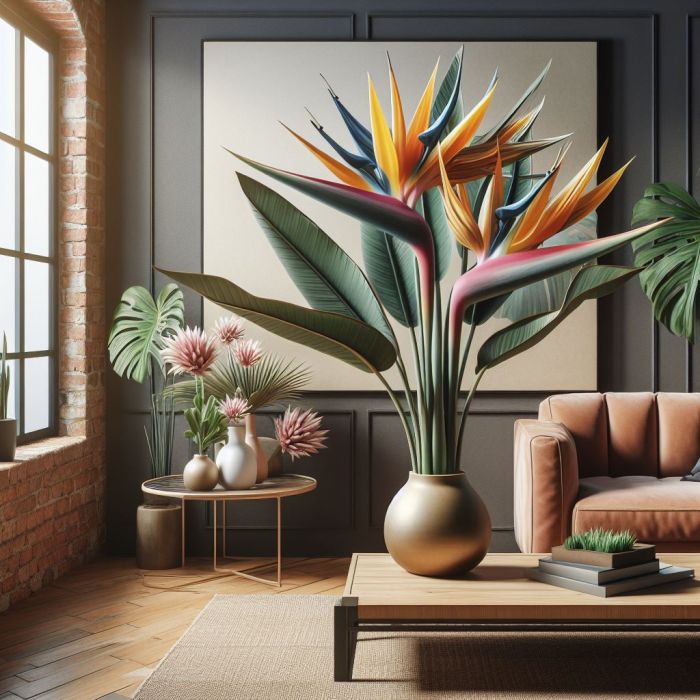
The Bird of Paradise plant big leaf houseplant is like a natural work of art, and its name gives a clue about its unique look. The leaves kind of resemble bird feathers or a bird in flight, bringing a touch of the exotic into your home.
- Growing Habit
This plant has a cool way of growing. The foliage sprouts in layers from a single central stalk, creating a fan-like arrangement. It’s like having your own mini tropical forest with leaves that give off an adventurous vibe.
- Plant Size
The Bird of Paradise can grow quite tall, giving your space a grand, jungle-like feel. It’s not just a regular-sized plant; it becomes a statement piece, adding a dash of the wild indoors.
- Leaves Size and Color
The leaves of the Bird of Paradise are no small matter. They can get pretty big, almost like having your green flags waving in the breeze. The color is deep green, and with their unique shape, they bring a vibrant and lively energy to your indoor oasis.
- Toxicity
It’s essential to know that, while the Bird of Paradise is stunning, its leaves can be toxic if eaten. So, it’s a good idea to keep it out of the way of pets and curious little ones.
4- Rubber Plant
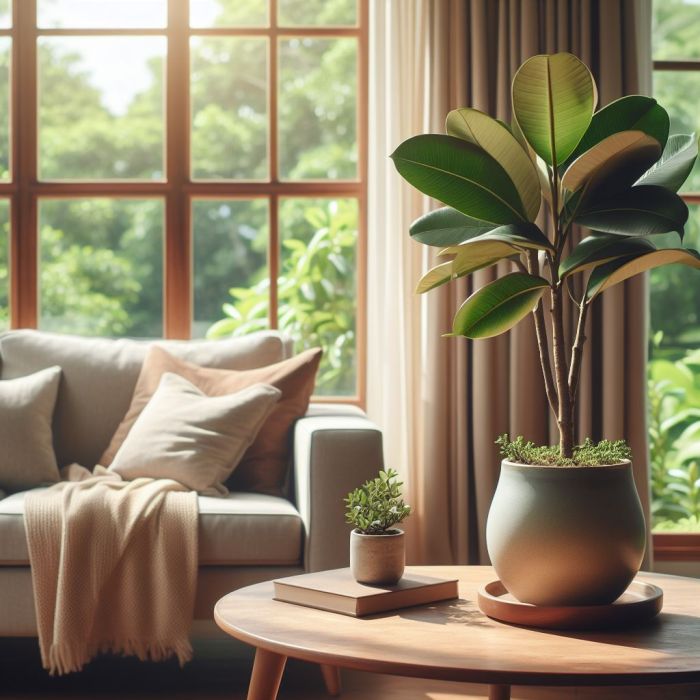
The Rubber Plant is like a big leaf houseplant in your home. Its strong and shiny leaves are big and look like green shields, making your indoor space feel bold and natural. It’s not just a plant; it adds a tough and cool touch to your home.
- Size
The Rubber Plant has a flexible size range, adapting well to the space available. It can be a compact addition to a tabletop or a larger, floor-standing plant depending on your preference and available space. Its adaptability makes it a versatile choice for various home settings.
- Care
The Rubber Plant is a low-maintenance big-leaf houseplant. It thrives in moderate to bright indirect light but can tolerate lower light conditions. When it comes to watering, it’s best to allow the top inch of the soil to dry out before giving it a drink. Regular wiping of its leaves helps keep them free of dust, ensuring optimal light absorption.
- Toxicity
The Rubber Plant is a tough and good-looking plant for your home, but its leaves have something inside that can be a little toxic if eaten. So, it’s a good idea to put it where pets and small kids can’t reach to make sure everyone stays safe and has a good time.
5- Philodendron Xanadu
Philodendron Xanadu is a stylish big-leaf houseplant that is deeply lobed and has a unique, tropical flair. The leaves are a lush green, and their glossy texture adds a touch of sophistication to any space. While not as large as some other big-leaf houseplants, the Philodendron Xanadu still offers a generous size that fills your room with vibrant greenery.
- Care
This plant is known for being easy to take care of. It enjoys moderate, indirect light but can adapt to lower light conditions. When it comes to watering, it’s best to let the top inch of the soil dry out before giving it a drink.
- Toxicity
While Philodendron Xanadu is a charming addition to your indoor garden, it’s important to note that its leaves contain substances that can be toxic if ingested. As with other houseplants, it’s a good idea to keep it out of reach of pets and small children to ensure everyone stays safe.
6- African Mask Plant
The African Mask Plant celebrated as a big-leaf houseplant, is a striking beauty with deep green leaves adorned with prominent light green or white veins, creating a visually arresting contrast. The leaves, elegantly shaped like arrowheads, bring an exotic and graceful touch to your indoor space. With their substantial size and distinctive appearance, these leaves contribute to the allure of the African Mask Plant as a noteworthy addition to the world of big-leaf houseplants.
- Care
This plant is quite accommodating, thriving even in low light conditions, making it an ideal choice for spaces with limited sunlight. Its ability to maintain its beauty with minimal light adds to its appeal as an easy-to-care-for houseplant.
- Toxicity
It’s crucial to note that the African Mask Plant comes with a cautionary aspect. While its presence is captivating, the plant is toxic to both pets and humans.
7- Majesty Palm
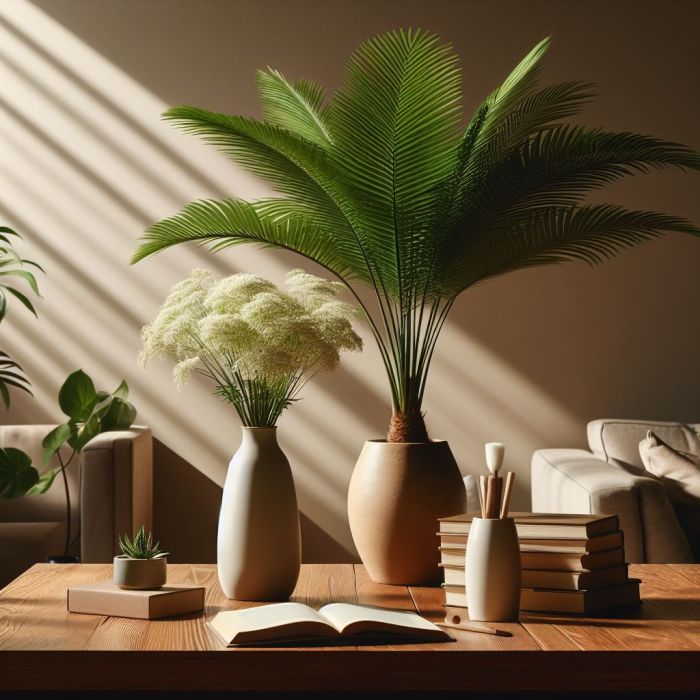
The Majesty Palm celebrated as a big leaf houseplant, captivates with its large fronds and multiple stems, but it can be a bit of a challenge when it comes to maintenance. This elegant and sizable plant demands specific care to thrive, making it a unique and rewarding addition to your indoor green haven.
- Challenges of Majesty Palm Care
The Majesty Palm, known for its beauty, requires meticulous care to thrive. Its maintenance can be a bit finicky, demanding attention to detail to create the ideal conditions for its well-being. This big-leaf houseplant flourishes in bright, indirect light and prefers a warm and humid environment. Striking this careful equilibrium is crucial to ensure its lush fronds remain vibrant and healthy, making the Majesty Palm a unique and elegant addition to your indoor space.
- Slow Growing
The Majesty Palm is not in a hurry to grow. Its growth rate is slow and steady, requiring patience from its caretaker. This gradual development adds to the plant’s overall grace, making each new frond a reward for the time and effort invested.
8- Philodendron Gloriosum
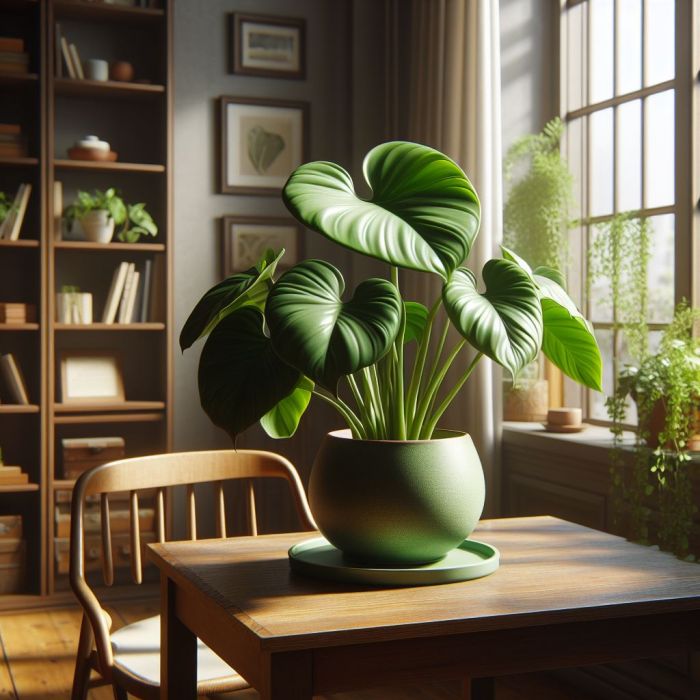
TheBird of Paradise, a notable big-leaf houseplant, is admired for its grandeur. However, its beauty comes with a charming difficulty in maintenance, requiring careful attention to detail for optimal growth.
- Optimal Light and Temperature
Creating an ideal habitat for the Philodendron Gloriosum involves finding the perfect balance of light and temperature. This majestic big-leaf houseplant thrives in bright, indirect light and enjoys a warm and humid environment. Achieving this precise balance is essential to ensure its large, lush leaves, adorned with white veining on deep green velvety surfaces, maintain their vibrancy.
- Rare Elegance
The Philodendron Gloriosum is not just any plant; it’s a rare find
9- Calathea Orbifolia
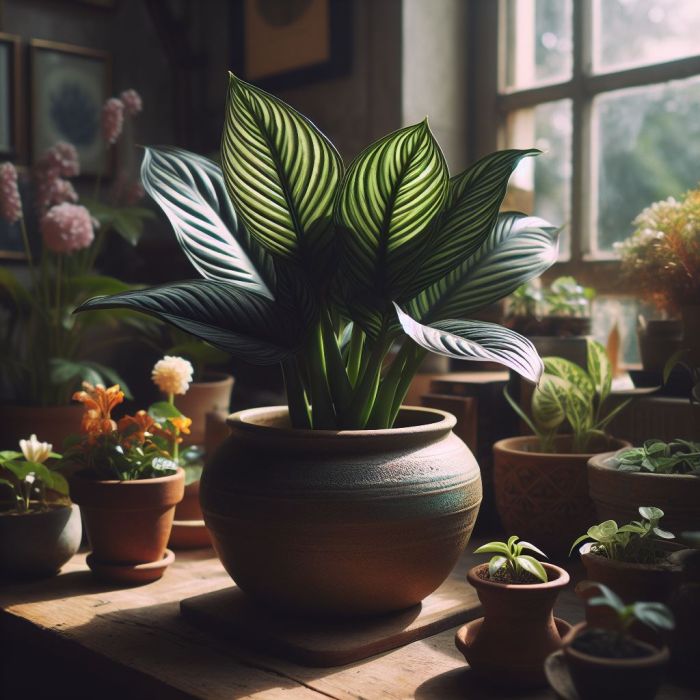
The Calathea Orbifolia, celebrated as a big leaf houseplant, boasts orb-shaped large leaves that make a striking statement in any indoor space. The distinct pattern and size of its leaves contribute to the plant’s majestic appearance.
- High Humidity Thrive
This grand houseplant thrives in high humidity, providing a lush and tropical feel to your indoor oasis. Its ability to flourish in moisture-laden environments makes it a preferred choice for those seeking a green companion in humid conditions.
- Challenging for Some Gradners
While the Calathea Orbifolia may pose a challenge for some plant lovers to keep indoors, its unique beauty and grandeur make the effort truly rewarding. With a bit of attention and care, this big leaf houseplant transforms your space into a green haven.
- Light Requirements
For optimal growth, the Calathea Orbifolia requires bright indirect light, simulating its natural habitat. Additionally, keeping the soil consistently moist without waterlogging is key to nurturing this majestic plant, providing the perfect conditions for its large, vibrant leaves to flourish.
10- Snake Plant

The Snake Plant, also known as Sansevieria, boasts an intriguing big leaf structure. Its leaves are upright and sword-shaped, adding a unique architectural element to your indoor space.
- Care Requirements
It’s an excellent choice for those new to plant care or with busy schedules. The big-leaf houseplant thrives in indirect light but can tolerate low-light conditions. Additionally, it doesn’t demand frequent watering, making it an ideal choice for those who may forget to water their plants regularly.
- Toxicity
While the Snake Plant is considered non-toxic, it’s safe to keep it out of reach of small children and pets. Like many houseplants, it’s always better to err on the side of caution.
In conclusion, the world of indoor gardening is graced by the majestic presence of big-leaf houseplants. These impressive botanical wonders not only bring a touch of nature indoors but also make a bold statement of elegance and grandeur. From the captivating Fiddle Leaf Fig with its violin-shaped leaves to the exotic beauty of the Bird of Paradise and the resilient nature of the Snake Plant, each big leaf houseplant adds a unique charm to your living space.
While they vary in care requirements, from the finicky Fiddle Leaf Fig to the adaptable Rubber Plant, these plants share a common thread of bringing lush, large leaves that transform your home into a green haven. So, whether you’re drawn to the rare elegance of the Philodendron Gloriosum or the striking beauty of the African Mask Plant, embracing big-leaf houseplants promises to elevate your indoor gardening experience, making a lasting statement in the heart of your home.


1 thought on “10 Beautiful Big-Leaf Houseplants”